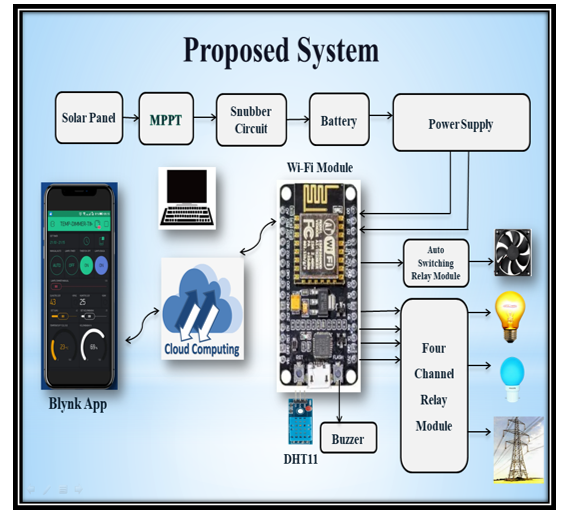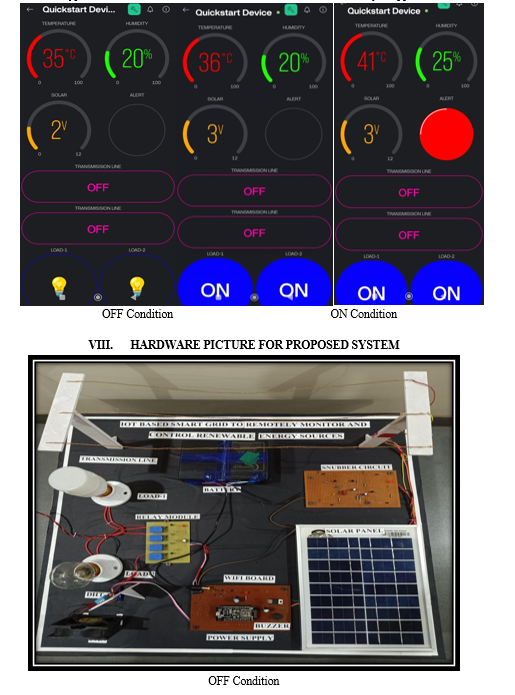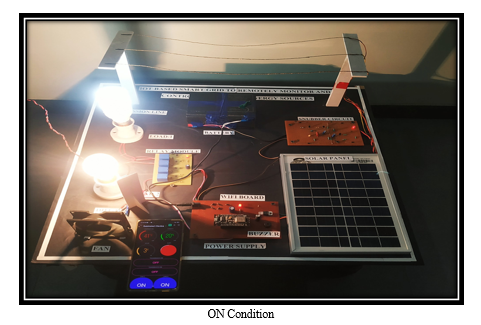Ijraset Journal For Research in Applied Science and Engineering Technology
- Home / Ijraset
- On This Page
- Abstract
- Introduction
- Conclusion
- References
- Copyright
IOT Based Smart Grid to Remotely Monitor and Control Renewable Energy Sources using Cloud Computing
Authors: Aishwarya Sanjay Sonawane, A. V. Naik
DOI Link: https://doi.org/10.22214/ijraset.2024.63236
Certificate: View Certificate
Abstract
The growing demand for clean and sustainable energy sources necessitates advancements in grid structure. This project explores the potential of an IOT-based smart grid to remotely monitor and control renewable energy sources. In this, we use solar energy as a renewable energy source, and with the help of cloud computing, we monitor and control different types of loads. The paper highlights the key components, functionalities, and benefits of such a system.The increasing demand for sustainable energy solutions fuels the development of smart grid technologies. This project proposes an IOT (Internet of Things)-enabled smart grid architecture for remote monitoring and control of renewable energy sources. The core concept involves integrating sensors with renewable energy sources like solar or wind turbines. These sensors collect real-time data on energy generation, environmental conditions, and system health. This data is then transmitted over a network to a central control system or a cloud platform for further analysis. By implementing remote control capabilities, grid operators can: regulate energy production based on demand; integrate storage solutions for surplus energy; and improve overall grid stability and reliability. The project concludes by outlining the benefits of this approach, including a reduced carbon footprint, cost savings, and a more sustainable energy future.
Introduction
I. INTRODUCTION
Electricity has been an important part of our daily lives. An electrical grid-interconnected network connects the generating station to the end user via transmission and distribution systems. A smart grid is an electrical network that integrates new information and communication technology, like connected devices. A smart grid transmits real-time information on electricity usage and consumption to all network operators. The essential features of a smart grid are to improve the efficiency, economic viability, and sustainability of the generation, transmission, and distribution of electricity through the use of information and communication technology.
Using an IOT-based solar power monitoring system, the cloud-based system provides solar monitoring and checks if there is a problem with the solar panel connection by lowering output. The NODE-MCU ESP8266 is the controller that monitors all the solar panel parameters. Monitor the solar panel and transmit the data to the Internet of Things (IOT). As soon as an output falls below a predetermined threshold, an alert is issued to notify users of an issue with solar panel connections or dust on the panel. This makes it possible to monitor the solar panel and ensure that it is producing the best amount of electricity possible.
The Internet of Things, explicitly “the Internet in which all the things are connected to each other," is the tremendous extension and expansion of the Internet network. Implementing the smart grid means including workstations and data exchange technology in the present electricity grid. A connection of digital technology, i.e., IOT, with the grid promises to work more efficiently and reliably. It can also use solar sources, which are more reliable and economical than wind and hydroelectric sources. Much like computer systems and communicating devices like routers, switches manage the flow of bits on the Internet; smart-grid technologies use statistics to optimize the effective use of electricity.
Problems Statement Nowadays, there are many problems in the conventional grid, such as electricity transmission loss, power outages, electro mobility, grid monitoring, the threat of cyber-attacks, etc.
Problem solution An IOT-based smart grid to remotely monitor and control renewable energy sources offers real-time monitoring and control capabilities.
Benefits include improved performance, remote monitoring and control, cost effectiveness, and energy optimization
II. EXISTING SYSTEM
The existing system that is already in use is for solar monitoring and sharing information through cloud computing. After the year 2021, researchers can use an IOT-based smart grid to remotely monitor and control renewable energy sources using various methods, such as the Very Large Scale Integration (VLSI) technique, Arduino, the Deer Hunting Organization Crow Search Algorithm (DHOCSA) method, etc.
III. PROPOSED SYSTEM
This project proposes a smart grid system for renewable energy sources based on IOT. By using the Node MCU ESP8266, we send and receive data over Wi-Fi. In this project, we use a solar energy source as a renewable energy source. The solar panel generates voltage, then it transfers to a battery. We use a 12 volt DC battery, which stores the voltage. After that, we use a power supply in that rectifier. A filter voltage regulator and LED indicator are provided. voltage regulator regulates the voltage and transfers the Node MCU ESP8266. We use different types of loads that are connected through the Node MCU ESP8266, and on the other side, we use the cloud computing method in the Blynk app we use for communication between smart phones and hardware. With the help of cloud computing, we monitor and control all the outputs of given loads.
IV. BLOCK DIAGRAM

V. COMPONENT USED
A. Solar Panel
Solar panel is the device that collects energy from sun and uses it to generate voltage.in our project we use 6V 5W solar panel. It can output 5 Watt of power at 6 Volts under ideal light conditions. It is 29 cm x 18.5 cm x 1.7 cm in size.
B. MPPT And SNUBBER Circuit
Maximum power point tracking it use for extracting maximum available power from solar panel under certain condition the voltage at which solar panel can produce maximum power is called maximum power plant .Snubber circuit are used for protecting against reverse current
C. Battery
Battery are used to storage generated voltage from solar panel we use 12v dc battery. When the solar panel produces more power than our usage, then the excess flows into our battery storage for later use. Batteries allow you to get the most out of our solar panel by storing excess solar energy instead of sending it out into the electric grid.
D. Power Supply
The basic building block of dc power supply is rectifier, filter, and voltage regulator. Rectifier is usually bridge types full wave rectifier in our project battery is connected to power supply that’s why dc supply provided to rectifier hence The bridge rectifier will simply act like a wire, allowing the DC current to flow through. ripple pulsating DC is reduce by filter which is connected after rectifier filter can be C type the output or the filter is smooth DC Voltage with small ripple the output of power supply is connected at the input of the voltage regulator circuit .the voltage regulator is a specially designed to keep the output voltage constant. IC used for voltage regulator is 7805 IC it used to produce +5v regulated DC voltage for TTL logic
E. NODE MCU ESP8266 Wi-Fi Module
Sensing Node MCU is open source software and hardware development environment that is built around very inexpensive system on a chip (SOC) called ESP8266.it use to send and receive data over Wi-Fi. A microcontroller and Wi-Fi for the home network required the ESP8266 collects electrical data from various sensors and send it to the Blynk for the data storage, remote control and real time monitoring.
F. FOUR Channel Relay Module
This The four channel relay module is a convenient board which can is used to control high voltage ,current load such as bulb,moter,solenoid valve, and AC loads.in our project we use four types of loads which are connected through this channel such as 100 W bulb , 5W bulb, transmission line and exhaust fan . Four channel relay is designed to integrate with microcontroller
VI. SOFTWARE USED
A. Arduino IDE
A microcontroller Arduino IDE is open source software analog or digital input signals can be read by Arduino boards and turns into output which can be connected to cloud Arduino board can be controlled by sending instructions via internet to its MCU
B. BLYNK
Basically Blynk is an IOT platform in addition to controlling hardware remotely display data (sensor) stores visualize it the main goal of this is to create an interface between humans and machine. Communication between smartphone and hardware is handling by this component.
C. CADSTAR PCB Layout
CADSTAR PCB layout is a software tool used for designing the layout of printed circuit board (PCB) it is part of tools offered by zuken that allows to design and verify electronics component.
VII. RESULTS
The prototype model was successfully implemented and tested. An IOT -based smart grid can be an excellent solution for remotely monitoring and controlling renewable energy sources. By incorporating various sensors and devices, it can collect data on energy generation, consumption, and storage. In our project, by using the Blynk app, we monitor and control different types of loads. Figures show the output of different types of loads such as bulbs, transmission line faults, fan on the Blynk application.


Working of project:
The goal of the project is to enhance efficiency and reliability. It means real-time data from sensors allows for monitoring and optimizing energy generation, consumption, and grid health. This reduces power loss, identifies maintenance needs early, and improves stability. By having better control and real-time data on renewable energy production, the grid can integrate these sources more effectively. This allows for regulating energy production based on demand, storing energy, and ultimately promoting a more sustainable energy infrastructure.“IOT-based smart grid to remotely monitor and control renewable energy sources” In our project, we use solar energy as a renewable energy source. We use solar panels to generate electricity, and then we connect the panels to the Snubber+ MPPT circuit (Maximum Power Point Tracking Circuit). This Circuit). This circuit is used for extracting the maximum available power from the solar panels. A Snubber circuit is used to protect against reverse current. then we use batteries to store the generated voltage. The battery is connected to our power supply. power supply is connected to our ESP8266 Wi-Fi module. It is used for sending and receiving data over Wi-Fi. It is connected to the cloud computing system with the help of the Blynk application, which shows the output of different loads that are connected to the relay module through the Wi-Fi module.Whenever we power supply a Wi-Fi module, we send a signal to the Blynk app, and our bulb (Load 1) will be ON with the help of node L1. In case of load 1, when the surrounding temperature of the bulb increases above a certain temperature, our exhaust fan (Load 2) will be automatically on. So it’s a controlling action in our project. then we use the transmission line (Load 3) whenever a fault occurs in a line, like a line-to-line fault. In that case, a buzzer will buzz, Blynk will show an alert message, and our whole system will automatically be turned off and protected against excessive damage. Accordingly, our whole system monitors and controls the loads, protecting against excessive damages and losses.
Conclusion
In conclusion, implementing an “IOT-based smart grid to remotely monitor and control the renewable energy source ” offers a significant advancement in the way we manage our power infrastructure its offers a powerful solution for optimizing renewable energy use. It promotes efficient and reliable power distribution, cost reduction and significant shift towards a more sustainable energy future. The project is reliable to implement and very customizable according to requirement. It provides very efficient methods of monitoring and controlling our renewable (solar) energy resources which would otherwise have been underutilized. It ultimately economical and help to minimize pollutions because of use of non -renewable energy source will reduce a carbon emission footprint. Finally it gives a very effective solution for implementing green energy techniques on a larger scale.
References
[1] Smart Grid Technologies: Communication Technologies and Standards Vehbi C. Gungor, DilanSahin, TaskinKocak, SalihErgüt, ConcettinaBuccella, Carlo Cecati, Gerhard P. Hancke [2] Federico Viani, Member IEEE, FabrizioRobol, Alessandro Polo, “Wireless Architectures for Heterogeneous Sensing in Smart Home Applications: Concepts and Real Implementation”, 2013 IEEE [3] F. Salvadori, Member, IEEE, C. S. Gehrke, A. C. de Oliveira, M. de Campos, and P. S. Sausen, “Smart Grid Infrastructure Using a Hybrid Network Architecture”, IEEE TRANSACTIONS ON SMART GRID, VOL. 4, NO. 3, SEPTEMBER 2013 [4] B. Becker, A. Kellerer, and H. Schmeck, “User interaction interface for energy management in smart homes,” in Proc. 2012 IEEE PES Innov. Smart Grid Technol. (ISGT) Conf., Washington, DC, USA, pp. 1–8. [5] Sebastian Meiling, Till Steinbach, Moritz Duge, and Thomas C. Schmidt, “Consumer-Oriented Integration of Smart Homes and Smart Grids: ACase for Multicast-Enabled Home Gateways?”, 2013 IEEE Third International Conference on Consumer Electronics - Berlin (ICCE-Berlin) [6] Saswat Mohanty, Bikash Narayan Panda “Implementation of a Web of Things based Smart Grid to remotely monitor and control Renewable Energy Sources,”volume: 2, 2014 IEEE Students’ Conference on Electrical, Electronics and Computer Science.2014 [7] Mahesh Hiremth, Prof: Manoranjan Kumar, “Internet of things for energy management in the home power supply”, Volume: 1 Department of International Journal of Research In Science & Engineering (2012). [8] Liu Hua1, Zhang Junguo*1, Lin Fantao a “Internet of Things Technology and its Applications in Smart Grid,” [9] TELKOMNIKA Indonesian Journal of Electrical Engineering, Vol.12, No.2, February 2014, pp. 940 ~ 946
Copyright
Copyright © 2024 Aishwarya Sanjay Sonawane, A. V. Naik. This is an open access article distributed under the Creative Commons Attribution License, which permits unrestricted use, distribution, and reproduction in any medium, provided the original work is properly cited.

Download Paper
Paper Id : IJRASET63236
Publish Date : 2024-06-10
ISSN : 2321-9653
Publisher Name : IJRASET
DOI Link : Click Here
 Submit Paper Online
Submit Paper Online

